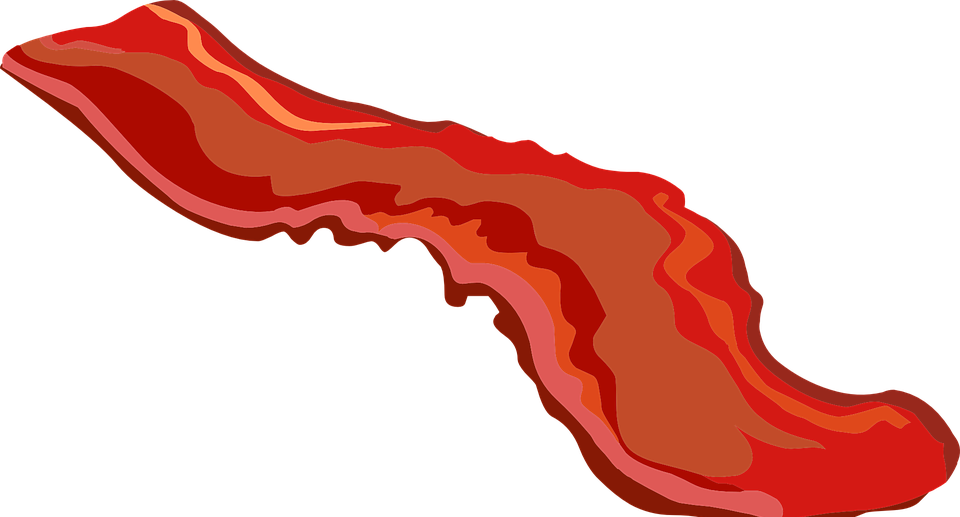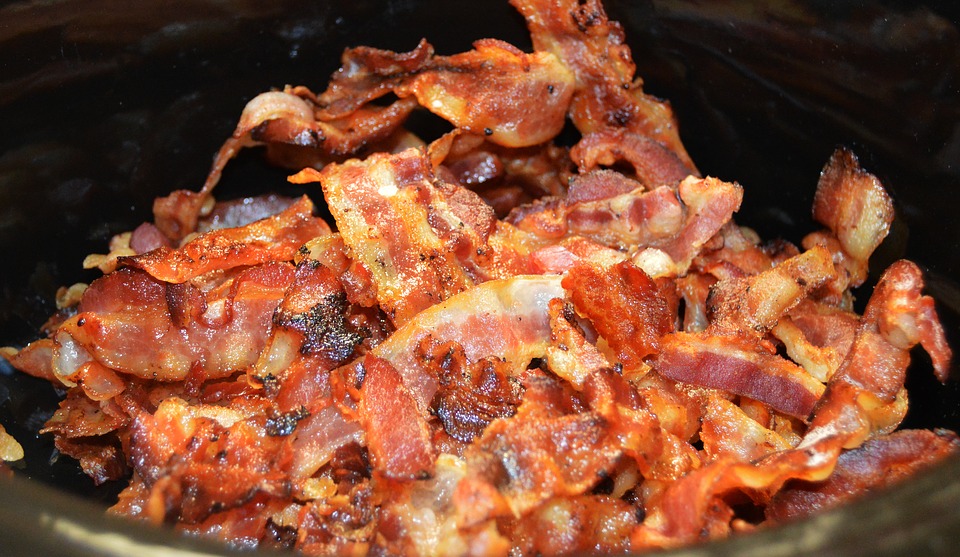Bacon, the beloved breakfast staple, is often a tempting treat for dog owners. However, the question of whether dogs can safely consume bacon is a complex one. This article delves into the risks and benefits of sharing this salty, fatty treat with our canine companions, exploring the potential dangers and how to make informed decisions about feeding bacon to our furry friends.
Part 1: The Risks of Bacon for Dogs

1.1 High Fat Content
Bacon is incredibly high in fat, especially saturated fat. This can lead to several health problems for dogs, particularly if consumed regularly or in large quantities. A single slice of cooked bacon can contain up to 7 grams of fat, which is a significant amount for a small dog.
1.1.1 Pancreatitis
The high fat content in bacon can trigger pancreatitis, an inflammation of the pancreas. This condition can cause severe abdominal pain, vomiting, diarrhoea, and lethargy. In severe cases, pancreatitis can even be fatal.
1.1.2 Weight Gain
Excess fat intake from bacon can contribute to weight gain, leading to obesity. Obesity, in turn, increases the risk of various health complications, including joint problems, diabetes, and heart disease.
1.1.3 Digestive Issues
The high fat content in bacon can also cause digestive upset, leading to diarrhoea, vomiting, and gas.
1.2 High Sodium Content
Bacon is notoriously high in sodium, which can pose serious health risks for dogs. A single slice of cooked bacon can contain up to 100mg of sodium, which is a considerable amount for a dog.
1.2.1 Salt Poisoning
Excessive sodium intake can lead to salt poisoning in dogs, characterized by symptoms like excessive thirst, vomiting, diarrhoea, tremors, and seizures. In severe cases, salt poisoning can be fatal.
1.2.2 High Blood Pressure
High sodium levels can contribute to high blood pressure, potentially increasing the risk of heart disease and stroke in dogs.
1.2.3 Dehydration
High sodium levels can also lead to dehydration, which can be particularly dangerous for dogs, especially older dogs or those with underlying health conditions.
1.3 Potential for Choking Hazards
The small, hard pieces of bacon can be a choking hazard for dogs, especially smaller breeds.
1.3.1 Choking
If a dog swallows a piece of bacon that is too large, it can become lodged in their throat, causing choking and potentially leading to suffocation. Choking is a life-threatening emergency and requires immediate attention.
1.3.2 Aspiration Pneumonia
If a dog inhales a piece of bacon into their lungs, it can lead to aspiration pneumonia, a serious respiratory infection. Aspiration pneumonia can cause coughing, difficulty breathing, and fever.
1.4 Potential for Bacterial Contamination
Bacon can also be a source of bacterial contamination, particularly if it is not cooked thoroughly.
1.4.1 Salmonella and E. Coli
Bacon can be contaminated with bacteria such as Salmonella and E. coli, which can cause food poisoning in dogs. Symptoms of bacterial food poisoning in dogs include vomiting, diarrhoea, lethargy, and fever.
1.4.1 Listeria
Bacon can also be contaminated with Listeria, a bacteria that can cause serious health problems in dogs, especially pregnant dogs and those with compromised immune systems.
1.5 Potential for Toxicity from Cured Meats
Bacon is often cured with nitrates and nitrites, which can be toxic to dogs in large quantities.
1.5.1 Methaemoglobinaemia
Nitrates and nitrites can interfere with the body's ability to carry oxygen, leading to a condition called methaemoglobinaemia. Symptoms of methaemoglobinaemia include weakness, lethargy, and bluish discoloration of the gums and tongue.
1.5.2 Cancer Risks
Some studies suggest that cured meats, including bacon, may increase the risk of certain types of cancer in dogs.
Part 2: Potential Benefits of Bacon for Dogs

While bacon poses several risks for dogs, it does offer some potential benefits, although these benefits are often overshadowed by the dangers.
2.1 Nutritional Value
Bacon contains small amounts of protein and essential vitamins and minerals, such as thiamine and iron.
2.1.1 Protein
Protein is crucial for muscle growth and repair in dogs. However, the protein content in bacon is relatively low compared to other sources, such as lean meats.
2.1.2 Vitamins and Minerals
While bacon does contain some vitamins and minerals, it is not a significant source of these nutrients. The vitamins and minerals found in bacon can be obtained from other, healthier sources.
2.2 Treat for Positive Reinforcement
Bacon can be an enticing treat for dogs, making it a useful tool for positive reinforcement during training.
2.2.1 Training Rewards
The high palatability of bacon can encourage dogs to learn new commands and behaviors. However, it is crucial to use bacon sparingly and avoid creating dependence on this treat. Many other safe and healthy treats are available for training purposes.
2.2.2 Bonding
Sharing small, occasional treats, such as bacon, can strengthen the bond between owners and their dogs. However, there are many other ways to strengthen the bond with your dog, such as playing games, going for walks, and providing affection.
Part 3: How to Safely Feed Bacon to Your Dog

While it's generally best to avoid feeding bacon to your dog, if you do choose to offer it, it's essential to do so safely and in moderation. It is important to remember that even a small amount of bacon can be harmful to your dog.
3.1 Choose Lean Bacon
Opt for lean bacon with a lower fat content to minimize the risks associated with high fat intake. Look for bacon labelled as "lean" or "low-fat".
3.1.1 Bacon Type
Turkey bacon tends to be lower in fat than traditional pork bacon.
3.1.2 Preparation
Cook bacon thoroughly to reduce the risk of bacterial contamination, but avoid excessive charring, which can create potentially harmful compounds.
3.2 Offer in Small Amounts
Limit the amount of bacon given to your dog, and only offer it as an occasional treat.
3.2.1 Frequency
Avoid giving bacon daily or even weekly. It should be a rare treat, perhaps once a month.
3.2.2 Amount
The size of the bacon piece should be appropriate for your dog's size and breed, ensuring they can comfortably swallow it. A small, bite-sized piece is sufficient for most dogs.
3.3 Supervise Your Dog While Eating Bacon
Closely monitor your dog while they are eating bacon to prevent choking and ensure they don't eat too much. This is especially important for puppies and small dogs.
3.3.1 Observation
Pay attention to your dog's body language and any signs of discomfort, such as coughing, gagging, or difficulty swallowing.
3.3.1 Intervention
If your dog shows signs of choking, immediately intervene and try to remove the bacon from their mouth. If you are unable to remove the bacon, contact your veterinarian or an emergency veterinary clinic immediately.
Part 4: Alternatives to Bacon for Dogs
There are many healthy and safe alternatives to bacon that can satisfy your dog's cravings for a treat.
4.1 Healthy Dog Treats
A wide variety of commercially available dog treats are formulated with high-quality ingredients and provide essential nutrients. Look for treats that are specifically designed for dogs and that are made with natural ingredients.
4.1.1 Natural Ingredients
Look for treats made with natural ingredients, such as meat, vegetables, and fruits. Avoid treats that contain artificial colors, flavors, and preservatives.
4.1.2 Low-Fat and Low-Sodium Options
Choose treats that are low in fat and sodium to minimize the risk of health problems.
4.2 Homemade Dog Treats
Homemade dog treats allow you to control the ingredients and ensure they are safe and nutritious for your canine companion. There are countless recipes for homemade dog treats using healthy ingredients like chicken, sweet potato, and peanut butter.
4.2.1 Recipes
Use reliable recipes from reputable sources to ensure that the ingredients are safe for dogs. There are many resources available online and in dog training books.
4.2.2 Safety
Research ingredients carefully to ensure they are safe for dogs and avoid using harmful ingredients such as chocolate, grapes, and onions. Always consult with your veterinarian if you are unsure about the safety of any ingredients.
Part 5: Signs of Bacon Toxicity in Dogs
If your dog has ingested a large amount of bacon, it's important to be aware of the signs of toxicity and seek immediate veterinary attention. If you are concerned about your dog's health after ingesting bacon, it is always best to err on the side of caution and contact your veterinarian.
5.1 Symptoms
Symptoms of bacon toxicity in dogs can include:
- Vomiting
- Diarrhoea
- Abdominal pain
- Lethargy
- Excessive thirst
- Tremors
- Seizures
5.2 Veterinary Care
If you suspect your dog has ingested a significant amount of bacon, contact your veterinarian immediately.
5.2.1 Emergency Treatment
Your veterinarian may recommend inducing vomiting or administering activated charcoal to absorb toxins.
5.2.1 Monitoring
Closely monitor your dog's condition and follow your veterinarian's instructions regarding follow-up care.
Part 6: FAQs
6.1 Can dogs eat cooked bacon?
Cooked bacon is still high in fat and sodium, posing risks for dogs. It's best to avoid giving cooked bacon to your dog.
6.2 Is bacon bad for dogs?
Bacon is considered unhealthy for dogs due to its high fat, sodium, and potential choking hazards. It can lead to various health problems, especially if consumed regularly.
6.3 Can dogs have a little bit of bacon?
While a small amount of bacon might not cause immediate harm, it's best to avoid feeding bacon to your dog altogether. If you choose to offer a small piece as an occasional treat, do so with caution and in moderation.
6.4 What if my dog eats bacon?
If your dog has eaten bacon, monitor them closely for any signs of illness. If they experience any symptoms, contact your veterinarian immediately.
6.5 What is the best alternative to bacon for dogs?
Healthy alternatives to bacon for dogs include commercially prepared dog treats, homemade treats using safe ingredients, and small amounts of lean meat cooked without added salt or seasonings.
6.6 What should I do if my dog is choking on bacon?
If your dog is choking on bacon, immediately intervene to remove the piece from their mouth. If you can't remove it, contact your veterinarian or an emergency veterinary clinic.
6.7 Is it safe to give bacon to a puppy?
Puppies are particularly vulnerable to the risks associated with bacon due to their smaller size and developing digestive systems. It's best to avoid feeding bacon to puppies altogether.
6.8 Is bacon safe for senior dogs?
Senior dogs often have pre-existing health conditions, such as heart disease and kidney problems, which can be exacerbated by high fat and sodium intake. It's crucial to avoid feeding bacon to senior dogs.
Everyone is watching
-

Can Dogs Eat Bananas? A Guide to Safe Treats
DOGS & PUPPIESThis comprehensive guide will delve into the world of canine nutrition, focusing on the popular question: can ...
-

Can Dogs Eat Oranges? (Is It Safe or Toxic?)
DOGS & PUPPIESThis article delves into the question of whether dogs can safely consume oranges. We'll explore the nutrition...
-

Can Dogs Eat Grapes? The Shocking Truth About This Fruit
DOGS & PUPPIESThis article delves into the controversial topic of grapes and dogs, exploring the potential dangers associate...
-

Why Do Dogs Eat Poop? Understanding Coprophagia in Dogs
DOGS & PUPPIESThis article delves into the perplexing phenomenon of coprophagia, the act of eating faeces, in dogs. We explo...
-

Can Dogs Eat Shrimp? A Guide to Safety and Risks
DOGS & PUPPIESThis comprehensive guide dives into the world of shrimp and dogs, exploring the potential benefits and risks a...
